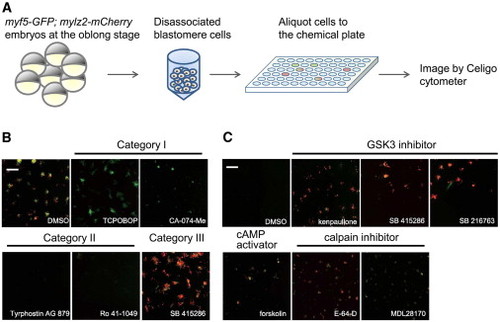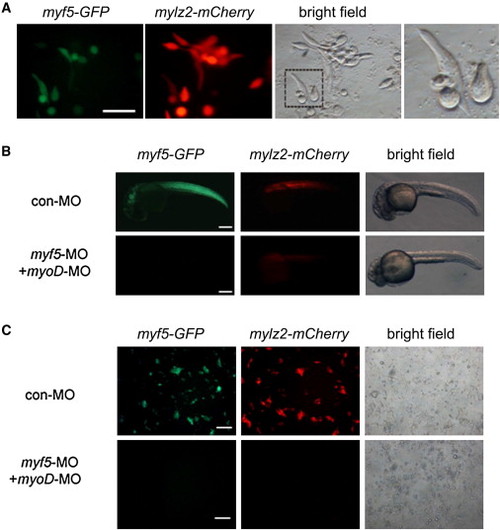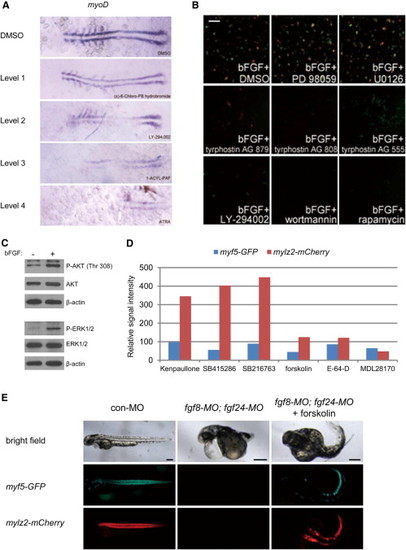- Title
-
A Zebrafish Embryo Culture System Defines Factors that Promote Vertebrate Myogenesis across Species
- Authors
- Xu, C., Tabebordbar, M., Iovino, S., Ciarlo, C., Liu, J., Castiglioni, A., Price, E., Liu, M., Barton, E.R., Kahn, C.R., Wagers, A.J., and Zon, L.I.
- Source
- Full text @ Cell
|
A Chemical Genetic Screen to Identify Modifiers of Skeletal Muscle Development (A) myf5-GFP;mylz2-mCherry double-transgenic expression recapitulates expression of the endogenous genes. myf5-GFP is first detected at the 11-somite stage. mylz2-mCherry expression is not observed until 32 hpf. Scale bars represent 200 μm. (B) myf5-GFP;mylz2-mCherry embryos were dissociated at the oblong stage and cultured in zESC medium. Images were taken 48 hr after plating. Scale bars represent 250 μm. (C) Expression of myogenic genes measured by qRT-PCR. Blastomere cells were cultured and harvested at 24 hr. Error bars represent SD from the triplicate reactions. All values are normalized to β-actin and expression data of basic medium (gray bars, lacking bFGF) are set to 1. (D) Expression of myogenic genes by different populations of blastomere cells isolated by FACS after 24 hr culture with bFGF. Error bars represent SD from triplicate reactions. Expression data are normalized to β-actin, and expression values of double-negative population (blue bars) are set to 1. See also Figure S1. |
|
Chemical Genetic Screens to Identify Modifiers of Skeletal Muscle Development (A) Schematic of a high-throughput image-based chemical screening assay. Approximately 800 myf5-GFP;mylz2-mCherry double-transgenic embryos were collected and dissociated at the oblong stage. Resulting blastomere cells were aliquotted into four 384-well plates with preadded chemicals. After 2 days, the 384-well plates were imaged and analyzed using a Celigo cytometer. (B) Sample images from the modifier screen. Hits could be grouped into three categories. Category I has only myf5-GFP expression. Category II has a decreased amount of both fluorescent colors. Category III has increased expression of both. Scale bars represent 250 μm. (C) Hits from the enhancer screen. Six chemicals that increase the GFP and mCherry signals were identified. Scale bars represent 250 μM. See also Figure S2 and Tables S1 and S2. |
|
Myogenesis Suppressors Identified In Vitro also Affect Muscle Development In Vivo, Related to Figure 1 (A) Higher magnification of myf5-GFP;mylz2-mCherry blastomere cells cultured in zESC medium with bFGF. Scale bar represents 50 μm. (B) myf5-GFP;mylz2-mCherry embryos injected with 400pg con-MO or co-injected with 200pg myf5-MO and 200pg myoD-MO lack both myf5-GFP and mylz2-mCherry expression. Images taken at 30 hpf. Scale bars represent 200 μm. (C) myf5-GFP;mylz2-mCherry embryos injected with 400pg con-MO or co-injected with 200pg myf5-MO and 200pg myoD-MO were disassociated at the oblong stage and cultured in zESC medium with bFGF. No myf5-GFP or mylz2-mCherry expression was detected in the culture of double morphants. Images were taken 26 hr after plating. Scale bars represent 200 μm. |
|
Chemical Genetics Screens to Identify Modifiers of Skeletal Muscle Development, Related to Figure 2 (A) Embryos were treated with chemical “hits” at the sphere stage. Once the control embryos reached the 6-somite stage, they were collected for whole-mount in situ hybridization with myoD riboprobe. Examples of hits verified to perturb muscle development in vivo. Flat mounted embryos stained with the myoD riboprobe at the 6-somite stage are shown with anterior to the left. Embryos were treated with (α)-6-Chloro-PB hydrobromide, LY-294002, 1-ACYL-PAF, or ATRA. All chemicals were from the CHB library and were diluted 300-fold. The level of myoD reduction was determined by comparing the intensity of myoD expression in these embryos with that in control embryos treated with DMSO. (B) myf5-GFP;mylz2-mCherry embryos were collected at the oblong stage and dissociated. The resulting blastomere cells were aliquoted into a 96-well plate with pre-added chemicals. The culture medium contained 10 ng/ml bFGF to promote muscle development. Cells were treated with 50 μM tyrphostin AG 879, 50 μM tyrphostin AG 808, 50 μM tyrphostin AG 555, 50 μM PD 98059, 10 μM U0126, 10 μM LY-294002, 10 μM wortmannin, or 20 μM rapamycin. Cells were imaged after 2 days using a Celigo cytometer for GFP, mCherry, and bright-field signals. Scale bar represents 250 μm. (C) bFGF treatment activates MEK/ERK and phosphoinositide-3-kinase (PI3K)-AKT signaling pathway in cultured blastomere cells. myf5-GFP;mylz2-mCherry embryos were collected at the oblong stage and dissociated. Resulting blastomere cells were cultured with or without bFGF. Cells were collected after 2 hr for Western blot. (D) Hits from a screen without supplementation of bFGF in the culture medium. myf5-GFP and mylz2-mCherry signals were quantified by Image J and normalized to the DMSO-treated sample. Some inhibitors identified in this sensitized screen (e.g., SB216763) were missed in the initial screen, possibly due to toxicity or other unanticipated issues associated with the limited dose range that can be assayed in such a chemical genetic screen (see also Figure S6). (E) 1-cell-stage myf5-GFP (green);mylz2-mCherry (red) embryos were injected with 250 pg fgf8-MO and 250 pg fgf24-MO and rescued by adding 10 μM forskolin at the dome stage. Scale bars represent 200 μm. |
Reprinted from Cell, 155(4), Xu, C., Tabebordbar, M., Iovino, S., Ciarlo, C., Liu, J., Castiglioni, A., Price, E., Liu, M., Barton, E.R., Kahn, C.R., Wagers, A.J., and Zon, L.I., A Zebrafish Embryo Culture System Defines Factors that Promote Vertebrate Myogenesis across Species, 909-921, Copyright (2013) with permission from Elsevier. Full text @ Cell




